
|
|
Abstract:
Brief overview of the history of Macau, and a detailed account of Bahá'í involvement 1953-1975, and stories of early believers.
|
All chapters
"Had I been feeling well, I would have taken a journey to China myself! China is the country of the future. I hope the right kind of teacher will be inspired to go to that vast empire to lay the foundation of the Kingdom of God to promote the principles of divine civilization, to unfurl the banner of the Cause of Bahá'u'lláh and to invite the people to the banquet of the Lord! "For the last twenty years I have repeatedly emphasized the matter of spreading the Cause of God. In every city there must be organised assemblies of teaching-classes to teach the young how to teach the Cause and prepare them for this most important service. "Every Bahá'í must acquire the lessons of teaching. This will yield results. No other service is as important as this. This service of the promotion of the Revelation of Bahá'u'lláh is the most confirmed service. Every time, one service holds the most supreme importance. "There is one season to harrow the ground, another season to scatter the seeds, still another season to irrigate the fields and still another to harvest the crop. We must attend to these various kinds of activities in their proper seasons in order to become successful. Now is the time of seed-sowing, but it seems to me some of the believers are thinking about crop-getting. This will give them no results. Whosoever is thinking of any other thing, is wasting his time. "The promotion of the principles of Bahá'u'lláh is the most dominant issue before the believers of God." `Abdu'l-Bahá (Star of the West, Volume VIII-April 28, 1917) In 1953 the Guardian of the Bahá'í Faith, Shoghi Effendi, set in motion his monumental Ten Year Crusade. It was a spiritual crusade which would take the Bahá'í Faith to the remaining areas of the globe where no Bahá'ís resided -- countries, territories or islands mentioned by `Abdu'l-Bahá in His Tablets of the Divine Plan. The Crusade would inaugurate the third phase of `Abdu'l-Bahá's Plan, a plan for teaching the Bahá'í Faith throughout the world. There were many consolidation areas, such as Japan, Korea, and the Philippine Islands, which already had resident Bahá'ís. There were administrative goals such as electing forty-eight additional National Spiritual Assemblies and acquiring properties in the name of the Faith to be used as Administrative Centers. There were to be a series of Intercontinental Teaching Conferences. Altogether the Guardian listed some twenty-seven objectives. He mentioned 131 virgin areas of the world where the Light of the Faith had not as yet penetrated. The Faith had to be taken to those areas. Macau was one of them. The first Bahá'ís to settle in those 131 areas were to be designated by the Guardian as "Knights of Bahá'u'lláh". History will no doubt view the Guardian's Ten Year World Crusade as a major turning point, not only in the Bahá'í Faith, but in the destiny of humankind. There surely had been nothing like it in the history of the planet. The Crusade lasted from Ridván 1953 to Ridván 1963, with hundreds of Bahá'ís leaving their native countries to proclaim the Faith throughout the world. The Crusade ended with a Congress in London, the "Great Jubilee", commemorating the one-hundredth anniversary of the end of the Bábí Dispensation and the beginning of the Dispensation of Bahá'u'lláh. It was reported that at the London Congress in 1963, congregated the most diverse assortment of nationalities and ethnic groups ever brought together at one time, thus far, in human history; over 6,000 Bahá'ís representing 260 countries, and additionally, representation of various ethnic groups. Only within the Bahá'í Faith could that have happened in those years. [+CHAPTER2] The Portuguese navigator Vasco da Gama (1460-1524) is usually credited with opening up the Far East although he only got as far as India. However, there is a statue in his honor in one of Macau's city squares. Jorge Alvares, in 1513, was actually the first Portuguese to visit China (Hong Kong), and the first European to reach China by sea. In the late 1500s Macau became a Roman Catholic missionary training center. It was also a refuge for Jews and Moslems claiming to be Catholic who were fleeing from persecution, and Protestant traders who had no place to live on the China coast. Macau became a Portuguese trade port in 1557, and Portugal paid the Chinese for its use. In 1845 Portugal declared it a free port and Macau officially became Portuguese territory in 1887. Macau was the historical spot where the first Peace Treaty between China and the United States was signed, in 1844. During World War II Macau was neutral and the population was thought to be about 600,000 as refugees from both China and Hong Kong flocked there. During a meeting between Portuguese and Chinese authorities in 1979 Macau was declared to be Chinese territory. Eight years later, 1987, the decision was made to return Macau to China on December 20, 1999. Negotiations with the British to return Hong Kong in 1997 were quite separate. In the 1950s when the first Bahá'ís settled in Macau the Chinese population was estimated to be about 200,000 with 4,000 Portuguese and other non-Chinese. In the 1980s the estimated population was about 400,000 contained in an area 16 square kilometers (6 square miles). The Portuguese colony of Macau consists of a peninsula and two islands, Taipa and Coloane. The city of Macau is approximately coextensive with the peninsula. Although it has often been called an island, it is connected to the China mainland by a narrow isthmus. Industries are mainly fishing, textiles and tourism (gambling). Cantonese Chinese is the language used in most schools and for practical purposes is the language of the colony. [+CHAPTER3]
Three Knights of Bahá'u'lláh. Mr. Carl Scherer, Mrs. Loretta Scherer and Mrs. Frances Heller. This photograph was taken in 1954. At that time, according to Mrs. Heller, Macau was like a Chinese village, although there were also many Portuguese in service with the Portuguese Army. Mrs. Heller rented a house at No. 9 Ave. Dr. Rodrigo Rodrigues. Shortly after she got settled a Chinese woman came to her and asked if she would teach her little boy English. It was Miss Mary Tung (Mrs. Shia). She became a Bahá'í January 1955, the first Chinese women to accept the Faith in Macau. On December 8, 1953 Carl and Loretta Scherer, from Wisconsin, U.S.A., arrived to settle in Macau. They rented the upper flat at No. 4 Ave. Jorge Alvares. Mr. Scherer had hoped to establish some kind of business. The Scherers also became Knights of Bahá'u'lláh. They with Mrs. Heller became the first Knights of Bahá'u'lláh to settle in Chinese territory. On March 1, 1954 at the Feast of Loftiness the three Bahá'ís officially formed the first Bahá'í group in what was designated as a virgin territory by the Guardian at the beginning of the Ten Year Crusade. Mr. Scherer was elected secretary. Apparently Mr. Scherer obtained Post Office Box No. 81 about that time. It is still being used by the Local Spiritual Assembly of the Macau Peninsula, over 35 years later. Those three Bahá'ís were joined by Mr. and Mrs. Hishmatullah Azizi, on May 8, 1954.
Miss Arden Thur (Lee), who stayed in Hong Kong for about three months visited the Bahá'ís of Macau in February 1954. This photograph was probably taken in Hong Kong about that time. Mr. and Mrs. Azizi are in the middle. The others were friends. Mr. and Mrs. Azizi wanted to pioneer to Hainan Island, located off the coast of mainland China. It was another of the 131 virgin area goals given by the Guardian, but as they could not obtain visas to Hainan, they first went to Hong Kong for three months. When they had to leave Hong Kong they went to Macau and stayed for five months, then back to Hong Kong. Mr. Azizi was trying to establish a business which would enable him to apply for a resident visa. Eventually he was able to do so, and his business prospered through the years. During those early years the Azizis divided their time between Hong Kong and Iran. They frequently went back and forth between Hong Kong and Macau doing great service for the Faith. 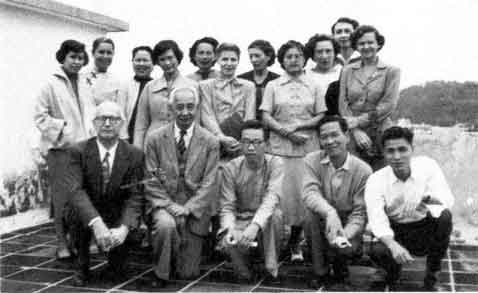 click for larger image This is a picture of Bahá'ís and their friends who attended the first Ridván celebration in Macau, April 21,1954. There were only three Bahá'ís in Macau at that time, Mr. and Mrs. Scherer and Mrs. Heller. Kneeling: Mr. Scherer, Mr. J. Botehlo, Mr. Sam Lau, Mr. Yim and Mr. Oliver Chiu. Standing in back: Miss Annie Ling, Mrs. Heller, Mrs. A.V. Ling, Ms. E.M. Canon, Ms. T. Maher, Mrs. Collazo, Mrs. Elsie Anfang, Ms. D. Ablamsaff, Ms. M. Cheu and Mrs. Ybarrolage. Of the guests shown above only Mr. Yim is identified in later pictures. The program that day consisted of a Bahá'í prayer, a Chinese prayer and prayers from the Bible and Koran, with an explanation of Ridván. 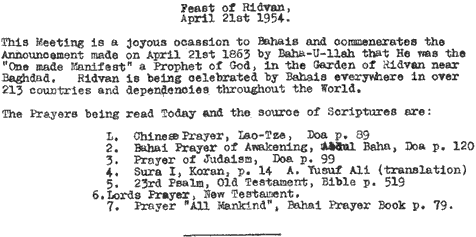 click for larger image Program of the first Ridván celebration in Macau, April 21, 1954.  click for larger image Devoted pioneers Mr. and Mrs. S.A. Suleimani visited Macau for one day, November 4, 1954, according to a notebook kept by the small Macau group. They lived in Shanghai for many years. In the early 1950s when it became difficult to continue living there, they decided to move to Taiwan which had no pioneers, to help establish the Faith. They stayed in Taiwan for the rest of their lives. From the left: Mr. Suleimani, Mrs. Heller, Mr. Yim, Mrs. Suleimani and Mr. Scherer. 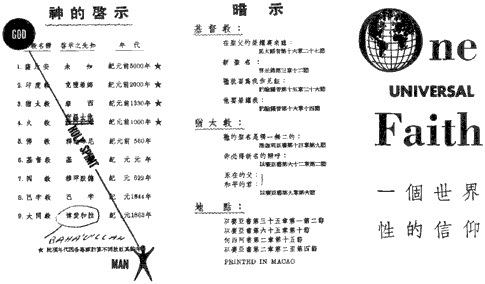 click for larger image In late 1954 or early 1955 the Macau Bahá'í group printed an introductory pamphlet in Chinese which they paid for themselves. The title was in two languages but the contents were only in Chinese. [+CHAPTER4] In October 1954 the second Macanese, Mr. Paul Kao declared. One day in August 1954 Mrs. Heller was fishing at the breakwater and a young man, a foreigner, came by and asked her if she would teach him English. He was Mr. Manuel Ferreira, a Portuguese. Mrs. Heller had him read the English edition of "Bahá'u'lláh and the New Era" side by side with the Portuguese edition. In that way he studied English and also learned about the Faith. He declared his belief in Bahá'u'lláh October 25, 1954, the first Portuguese to become a Bahá'í in Macau. Mrs. Heller left Macau to return to the United States November 4, 1954. Gradually the number of declarations increased. The first enrollments were as follows:
Administratively, Macau was under the National Spiritual Assembly of the United States and as people declared their belief in Bahá'u'lláh, their enrollment cards were sent to the Asia Teaching Committee of the National Spiritual Assembly of the United States for approval. Often the enrollment date was a month or so previous to the approval date by the Asia Teaching Committee. Sometimes the actual enrollment date was not registered. After the National Spiritual Assembly of North East Asia was elected (1957) all the declaration cards were sent to that administrative body. None of the Macau believers was native born, and some apparently left the country soon after declaring their belief in Bahá'u'lláh. A large portion of the inhabitants of Macau was quite transient as Macau was considered a stepping stone to somewhere else. Enrollments increased but so did exits from the country. Four Naw-Rúz Celebrations
A Naw-Rúz celebration on March 20, 1955 at 8 PM. There were twelve visitors and six Bahá'ís present in all. In this photograph, seated: Mr. Paul Kao, Mrs. Scherer, Miss Mary Tung (Shia), Mr. Wu, Mrs. Liu and Mr. Scherer. Standing: Mr. William Yang, Mr. Chu, Mr. Yim, Mrs. Chu, Mr. Wong, Mr. Wong, Mr. Tsang, and Dr. Liu.  click for larger image A Naw-Rúz celebration, March 21, 1956 at Mr. Scherer's residence. Seated: Mr. Scherer, Mrs. Chang, the Changs' son, Mrs. Liu, Miss D.M. Maclean (Vice British Consul to Macau), Mr. Paul Kao and Dr. Liu. Standing. Mr. John Chang, Mr. K.M. Wong, Mr. Anfang, Mr. William Yang, Mr. Min, Mr. Yim and Mrs. Scherer. There were eight guests and six Bahá'ís. 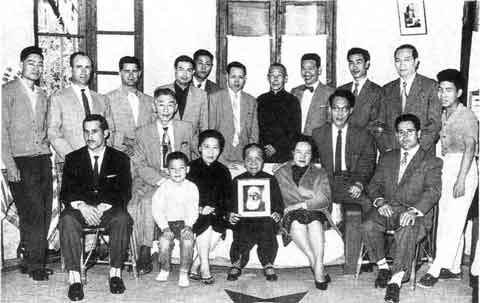 click for larger image Naw-Rúz 1959 at Mr. John Chang's residence. Eleven guests and eight Bahá'ís were present. Seated: Mr. Domingos Vilas, Mr. John Chang, the Chang's son, Mrs. Margaret Chang, Mrs. Pansi Yim, Mrs. Liu, Dr. Liu, and Mr. Joaquim Canhita. Standing: Mr. Ng, Mr. Amaral, Mr. Julio Mata, Mr. Jimmie Yuen, Mr. Chong, Mr. T.M. Wu, Mr. Yip, Mr. Harry Yim, Mr. Peter Chow, Dr. Lau and Mr. Liu. By this time there were no American pioneers in Macau but there were still several Bahá'ís attached to the Portuguese Army. Eventually they all left as their tour of duty finished. 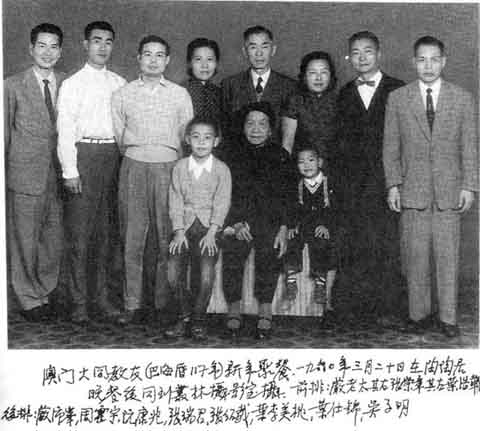 Naw-Rúz celebration, 1960, held at Tao Tao Chu. [+CHAPTER5] Mr. Harry Yim Harry Yim was the first person in Macau to declare his belief in Bahá'u'lláh. He wrote his name as Yim Pui Foung although the name on his I.D. card was spelled Yim Pu Foung. He also had an identity card for Hong Kong. He was born in 1915 and was originally from Canton, China. His family was prosperous exporting jade, antiques and embroidery. His wife was killed in China two years after their marriage, during World War II. They did not have children. He did not give details of this situation but told the compiler that that was why he was so lonely through the years. His father's export business was finished during the war and Harry went to Macau taking his younger sisters. He had different jobs; teaching English, buying and selling. After the war he went back to Canton to try to establish a business but with no success. He returned to Macau and started an antique and curio shop. He learned of the Faith from the Scherers in 1954. Loretta Scherer came into his shop one day looking for a wooden statue. Harry studied with the Scherers for a few months and became a Bahá'í; the first person in Macau to enroll as a member of the Bahá'í Faith. After that, he said he felt that nothing was as important as the Faith. He considered that his spiritual birthday was July 15, 1954, which was the day he decided to declare his belief in Bahá'u'lláh, although the date on his card as countersigned (approved) by the Asia Teaching Committee was September 30, 1954. Through the years Mr. Yim, along with Mr. John Chang, kept the affairs of the Faith going. Both could speak and write fluent English and made many reports to the mother assembly (after 1957), the National Spiritual Assembly of North East Asia. Mr. Yim came to Japan twice, once to attend the first teaching conference in North East Asia, at Nikko Japan in 1955. The second time was as a delegate from Macau to the third Annual Convention of the Bahá'ís of North East Asia, April 1959, in Tokyo. In the early days, the five pioneers, the Scherers, Mrs. Heller and the Azizis all traveled, but Mr. Yim was the only Chinese Bahá'í from Macau to come to Japan. One of the Japanese Bahá'ís tried to find a Japanese bride for Harry but that idea did not succeed. Personally Harry was a nice looking man, with a winning smile, and deeply interested in the progress of the Faith of Bahá'u'lláh. Harry's mother became a Bahá'í in December 1959 during the visit of Hand of the Cause Mr. Ala'i but her enrollment card was approved a month or so later. She was elected to the Local Spiritual Assembly of the Bahá'ís of Macau in 1960. In the fall of 1960 his mother died but Harry was consoled because she had declared as a Bahá'í the year before. When she was terminally ill he wrote a touching letter to the secretary of the National Spiritual Assembly of North East Asia asking about the Bahá'í method of burial, and we can recall that he asked if it was permissible to use joss sticks. He was very sad, but wanted to do things properly. After her death he wrote to the National Spiritual Assembly of North East Asia, "My mother had six children and her age was 75. She gained everything in this material world and now she has an open door to a new and greater life!" 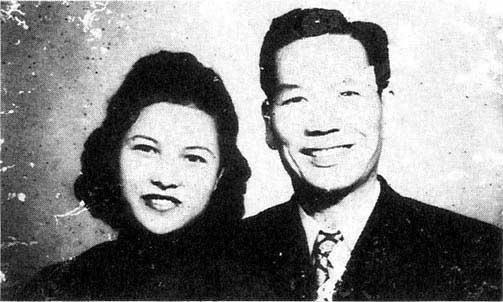
Mr. Harry Yim, as a very young man, is shown here with his wife. They had been married just two years when she was killed in China during World War II. He said that was why he had been lonesome through the years. 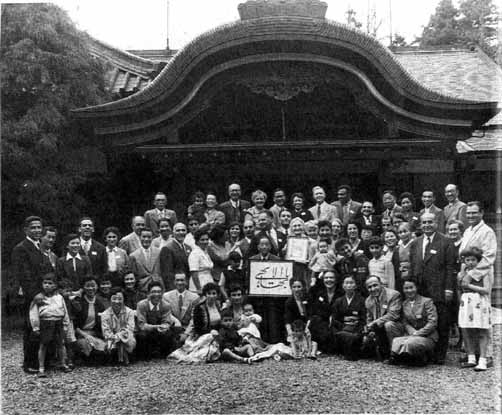 click for larger image Nikko, Japan, 1955 This teaching conference, which was sponsored by the National Spiritual Assembly of the United States, was approved by the Guardian of the Faith. Hand of the Cause Mr. Khadem was his representative. The Local Spiritual Assembly of Tokyo made all arrangements as there was yet no National Spiritual Assembly in the North Pacific. Mr. John Chang Mr. Chang was Dean of Students and an English teacher at the Leng Nam Middle School when he became a Bahá'í. In 1961 he became Headmaster of the English Department. It was a Christian school but non-denominational. Between 1958 and 1960 Mr. Chang gave two lectures on the Bahá'í Faith at the Chapel. Some of his students came to meetings. Other early Bahá'ís were also school teachers; Mr. Kao and Mr. Chow, and Mr. Yip. 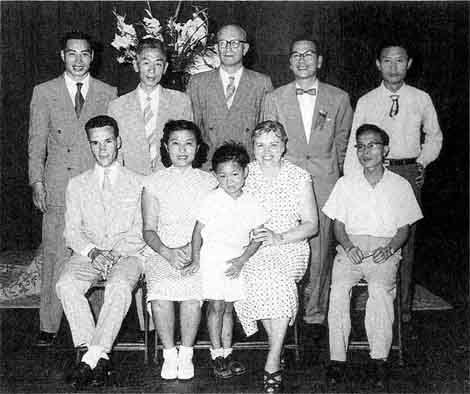 click for larger image May 22, 1955. With the declaration of Mr. John Chang the group reached nine. However, at that time it was only possible to form local spiritual assemblies at Ridván. That meant the group had to wait until the next year to accomplish that goal. The next year and the following year it was not possible either because of people leaving. Finally in 1958 they were able to accomplish the goal they had been striving for. Mrs. Mary Shia Mrs. Shia went to Macau from the Chinese mainland in 1950. She and Mrs. Heller became friends in late 1953 or early 1954. As mentioned before, she became a Bahá'í in January 1955, thus being the first Chinese woman in Macau to become a Bahá'í, and among the first women of her race to accept the Faith. Her husband became a Bahá'í in April 1955. The next year, 1956. they moved to Hong Kong, where they were prominent in the development of the Faith. They were both members of the first Local Spiritual Assembly of the Bahá'ís of Hong Kong, 1956. In 1958 Mr. and Mrs. Shia went to Cambodia. The same year they wrote to the Macau friends of the first Bahá'í enrollment in Cambodia. They helped to establish the first Local Spiritual Assembly of Phnom Penh. Mr. and Mrs. Shia eventually returned to Hong Kong where they stayed. [+CHAPTER6] The first Ridván celebration in Macau was held April 21, 1954. Sixteen people attended, but there were still only three Bahá'ís at that time. Occasionally they had visitors. One of the early visitors was an attractive young American Bahá'í Miss Arden Thur, who came in February 1954. At that time she was staying in Hong Kong temporarily. On May 1, 1954 Mr. Carl Scherer was appointed a member of the Auxiliary Board of the Hands of the Cause of God in Asia. The jurisdiction was South East Asia. In October 1957 the area of jurisdiction was changed to Japan, Korea and the North Pacific. After his appointment he sometimes traveled to other countries. The arrival of Mr. and Mrs. Azizi in May that year raised the number of Bahá'ís to five but still there were no Bahá'ís native to the area. In October the Azizis left to reside in Hong Kong. As mentioned previously they tried to get visas to Hainan but could not and were in Macau awaiting visas to Hong Kong. He established a business in Hong Kong so he would qualify for a visa. In May 1954 the Macau Bahá'ís (still only four) started a Sunday deepening "Worship Hour", which apparently continued for some time. In 1954 the Macau group was thrilled to receive a letter from the Guardian dated May 11, 1954. It was the only one they were to receive. They noted that it took three months to reach them. Considering how remote Macau was in those years, the small community had many Bahá'í visitors anxious to help in any way they could. In addition to those mentioned elsewhere in this record the following people should be acknowledged.
The Bahá'í community of Macau received one letter from the Guardian, Shoghi Effendi. It took three months to reach them. The original letter is now in the Archives in the Holy Land. In June 1954 Mr. Charles Murray visited for several days. A devoted Canadian Bahá'í, he was staying in Hong Kong trying to help the Faith. As he could not find employment in Hong Kong he returned to Canada in 1955. June 14, 1954 Mr. and Mrs. Mottahedeh (Mildred and Rafi) visited Macau. Mrs. Mottahedeh spoke at a meeting to which nineteen people came, thirteen of them non-Bahá'ís. In the eighth year of the Ten Year Crusade (1961) Mrs. Mottahedeh was elected to the International Bahá'í Council in the Holy Land, which the Guardian said was the "forerunner of the supreme administrative institution." In July Mr. Jamshed Fozdar visited Macau and they had a meeting to which thirteen people came, including seven non-Bahá'ís. In October 1954 Mr. and Mrs. Seto visited Macau. The Setos (Anthony and Mamie) were early American pioneers to Hong Kong. Mr. Seto was one of the first Bahá'ís of Chinese background. He and his wife accepted the Faith in Hawaii in the fall of 1916. Although Mr. Seto was an American citizen, he was of pure Chinese ancestry. He and his wife chose to pioneer to Hong Kong, arriving October 1, 1954, because he could speak Cantonese Chinese. They were both extremely important in the rise and development of the Faith in Hong Kong. Mrs. Seto had been a member of the National Spiritual Assembly of the Bahá'ís of the United States, and she was a well-known speaker. She was appointed as Auxiliary Board Member in April 1958 by the Hands of the Cause of God in Asia. Mr. and Mrs. Seto attended the first National Convention of the Bahá'ís of North East Asia in Tokyo in April 1957. A few days after the convention, Mr. Seto was stricken with a heart attack as they were boarding the airplane to return to Hong Kong. He was buried in the Foreigner's Cemetery in Yokohama, Japan. Mrs. Seto went back to Hong Kong alone where she stayed until the end of the Ten Year Crusade. In 1955 Miss Virginia Breaks, Knight of Bahá'u'lláh, pioneer to the Caroline Islands, visited Macau on her way back from the Nikko Conference in Japan. Also Mrs. Luava Carter visited Macau with Mr. and Mrs. Seto. In 1956 Mr. and Mrs. Charles Bishop included Macau as one of their stops on an extensive trip. 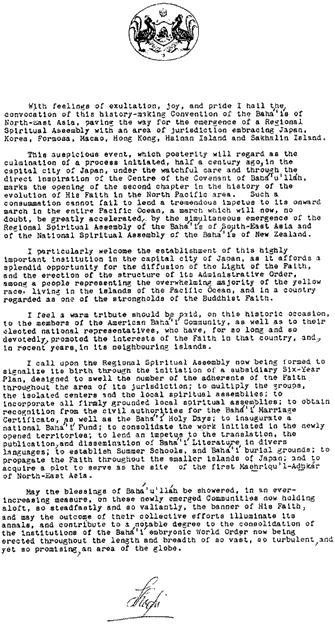 click for larger image 22 Spiritual Assembly of North East Asia The first National Convention of the Bahá'í of North East Asia was held in Tokyo, April 1957. The North East Asia area was extremely large, encircling Japan, Korea, Formosa (Taiwan), Hong Kong, Macau, Sakhalin Island and Hainan Island. At that time it was not possible to obtain visas for the Soviet territory of Sakhalin, nor for Hainan Island belonging to China. Mr. John Chang journeyed to Hainan in 1959 but left no resident Bahá'í. Hainan was taken out of the territory of the National Spiritual Assembly of North East Asia and assigned elsewhere. Sakhalin remained one of the goals, first, of the National Spiritual Assembly of North East Asia and then of its successor, the National Spiritual Assembly of Japan. It took thirty-three years to fulfill the goal. In the interests of history, a copy of Shoghi Effendi' s message to that first National Convention of the Bahá'ís of North East Asia is printed here. It was presented to the Convention by the Guardian's representative, Hand of the Cause Mr. Jalal Khazeh. From outside Japan representatives attended from Taiwan, Korea, and Hong Kong, but unfortunately not from Macau. With permission from the Guardian Mrs. Heller left Macau on November 4, 1954. She later continued her pioneer services in Mexico. The day she left Macau Mr. and Mrs. Suleiman A. Suleimani visited for one day. This couple had spent many years in Shanghai, where her father, Mr. Uskuli, had a business. He remained in Shanghai until his death in 1956 and is buried in the Shanghai Kiangwan cemetery. The Suleimanis were on their way to Taiwan, the first Bahá'ís to pioneer there. This devoted couple remained at their post in Taiwan until they died, she in 1981 and he in 1987. On January 16, 1955 the Bahá'ís held a World Religion Day meeting, with Mr. Scherer speaking. Nine non-Bahá'ís and four Bahá'ís attended. In March 1955 the community was happy to receive a letter from the Hands of the Cause residing in the Holy Land, signed by Mr. Leroy loas. It was in answer to their Naw-Rúz greeting. The group printed an introductory pamphlet in Chinese that year. Both the National Spiritual Assembly of the United States and its Asia Teaching Committee wrote them glowing letters of appreciation for their endeavors, the latter writing, "As the first Bahá'í group to be formed in the areas assigned to this committee under the World Crusade, we are very proud of you." 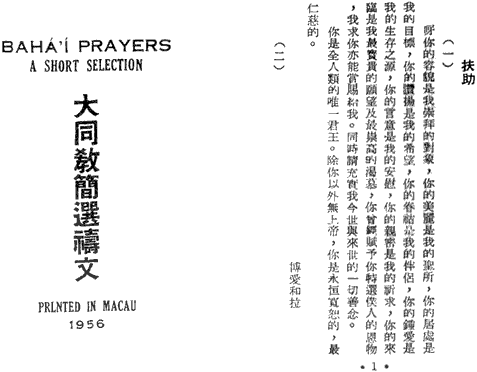 click for larger image The First Prayer Book in Chinese There had been translations of Bahá'í literature into Chinese in the 1930s and 1940s by Prof. T.S. Tsao and Mr. Chan S. Liu in mainland China. However, this was the first prayer book to be translated into Chinese. It was done by Mr. John Chang and printed in 1956. Shown here is the title page and first page. The outside cover is dark green. Mr. Chang thought there should be some prayers for the growing Macau community. He selected 22 suitable ones from an American prayer book. Several years later he added more prayers and another prayer book was printed in Chinese by the Chinese Translation Committee in Taipei, Taiwan in 1961. On May 22, 1955 with the declaration of Mr. John Chang the group membership reached nine. However, at the time, Local Spiritual Assemblies could only be formed at Ridván so the group did not qualify. In 1955 the Macau group was invited to send a representative to the Asian Teaching Conference, held in Nikko, Japan. It was the first Bahá'í conference in Asia, and great importance was attached to it. Hand of the Cause Mr. Zikru'llah Khadem was the Guardian's representative. Miss Charlotte Linfoot, a member of the National Spiritual Assembly of the United States was assigned to represent that assembly, which was the sponsor of the conference. The Tokyo Local Spiritual Assembly made all arrangements as there was still no National Spiritual Assembly in North East Asia. Representatives came from Guam, Taiwan, Korea, Iran, Caroline Islands, Hong Kong and Macau. There were about sixty adults and several children of pioneers. Mr. and Mrs. Scherer and Mr. Harry Yim attended from Macau. Mr. Yim with his warm personality made many friends in Japan, and he could also get a broader vision of the Faith.  click for larger image Mr. Philip Marangella, who lived in Japan but was an inveterate traveller and spreader of the Teachings, visited Macau in 1957. He is shown here on the left. Mr. and Mrs. Chang are in the middle with Mr. Yim on the right. In 1956 there was an important "first". Mr. John Chang translated 22 prayers from the American prayer book into Chinese. That small blue prayer book, printed in Macau in 1956, was the first prayer book in Chinese, although other books had been translated into Chinese some years earlier by T.S. Tsao and Chan S. Liu. Mr. Liu had some of his translations printed in Macau on a personal basis long before a community existed there. Some years later, in 1961, the small prayer book was expanded and printed in Taipei, Taiwan, by the Chinese Translation Committee of the National Spiritual Assembly of the Bahá'ís of North East Asia. That printing was done in collaboration with Mr. Chang. On April 19, 1957 the resident Bahá'í pioneer, Mr. Scherer, had an interview with the governor of Macau, Mr. Pedro Correia de Barros. The governor mentioned that he had heard of the Faith in Mozambique, Africa, which at that time was under Portuguese rule.  click for larger image Mr. William Smits, pioneer to Korea, Mr. William Jasai, a Portuguese soldier and Mr. Nari Sherwani, who as a youth was among the first to accept the Faith in Hong Kong. This photo was taken in Macau in 1957. Mr. Jasai was studying the Faith and became a Bahá'í the following April. He was a member of the first Local Spiritual Assembly of the Bahá'ís of Macau, 1958. He left shortly after to return to his home in Africa. The Macau community consisted of nine Bahá'ís in April 1957 but Mr. Paul Kao felt he had to resign from the Faith which he did on April 20 as he had accepted a position in a Catholic school. To the disappointment of the other eight believers they could not form a Local Spiritual Assembly, which had been their goal. The late 1950s saw more visitors to Macau: Mr. William Smits, who was pioneering to Korea visited Macau three times. One time he stayed over two weeks. The Macau secretary wrote to the mother assembly that Mr. Smits was a great gain for the Bahá'ís as he never tired of talking about the Faith. Miss Lecile Webster, who was traveling with Mrs. Thompson came through Macau. Mrs. Jeanne Frankel and her mother Mrs. Margaret Bates came in 1958 as did Mr. William Maxwell, pioneer to Korea. Mr. Maxwell was chairman of the National Spiritual Assembly of the Bahá'ís of North East Asia. A meeting was arranged and he spoke on World Brotherhood to the 16 people who came, nine guests and seven Bahá'ís.  click for larger image Mr. and Mrs. Anthony Seto (middle), early pioneers to Hong Kong visited the Macau group October 1954. Mrs. Heller is sitting to the left; Mrs. Scherer to the right. Standing are Mr. Yim, Mrs. Azizi and Mr. Azizi. Mrs. Edith Danielsen-Craig, pioneer to Taiwan, Mr. Yadollah Rafaat, pioneer to Japan and Mr. and Mrs. Noureddin Mumtazi visited at different times in 1959. Mr. Rouhollah Mumtazi (appointed as Counsellor in 1968) visited the Bahá'ís of Macau several times. The Mumtazis were pioneers to Japan. In 1960 the well-known Bahá'í teacher Mr. Mohammad Labib, visited Macau and went on a teaching trip to Taipa and Coloane. Mr. Jack Davis, pioneer to the Philippines visited in 1960. Of course, the Hong Kong Bahá'ís often went to Macau to help with the teaching; Mr. Azizi, Mr. and Mrs. Datwani and Mr. Nari Sherwani. Mr. and Mrs. Datwani accompanied pioneer to Japan Mrs. Joy Earl, to Macau in 1956. 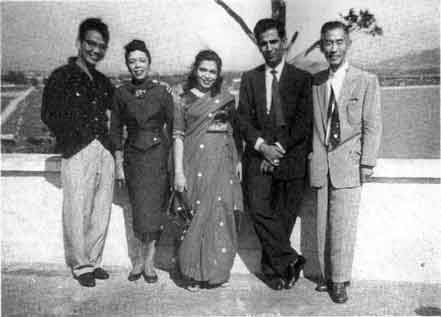 click for larger image Mrs. Joy Earl, pioneer to Japan, second from the left, was taken for a visit to Macau by Mr. and Mrs. Datwani of Hong Kong, second and third from the right, October 17 and 18, 1956. They attended the regular Sunday fireside. Mr. Chang is on the right and Mr. Yim is on the left. 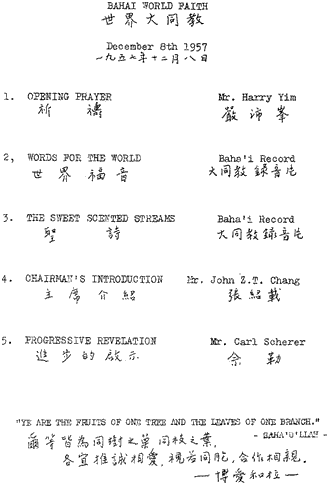 click for larger image This was the program for the first public meeting in Macau. It was mimeographed on pale blue paper. Although there were difficulties finding a place to hold the meeting attendance was the best ever, a total of twenty-two people including fifteen seekers. On December 8, 1957 the community held their first public meeting. According to an account written by Mr. Scherer, they had difficulties from the beginning. They reserved a room in a local high school. But the Presbyterian Church brought pressure to bear and permission was canceled. Then a primary school gave them permission to use one of the rooms. Another Protestant church applied pressure on the principal so that the primary school would withdraw permission. However, due to the intervention of Mr. Chang, permission was once more granted. The advertisement in the newspaper had to be altered suddenly but the meeting resulted in the largest non-Bahá'í audience ever; fifteen people. There was a total of twenty-two people including the Bahá'ís. Mr. and Mrs. Datwani and Mr. Sherwani came from Hong Kong to attend this first public meeting. Those three Bahá'ís held Indian passports. Some time after that Macau was closed to possessors of Indian passports and the three were unable to make more trips to Macau for a time. Thirty paid advertisements were inserted in the newspapers that year, including the one advertising their first public meeting. Teaching work was started in Coloane and Taipa, but there were no enrollments until several years later, in 1972.  A Naw-Rúz greeting printed in the newspaper March 21, 1958 During 1957 the community was quite active. There were ten general meetings, they observed all Feasts, had several special meetings for guests, but there were no enrollments. Mr. Scherer wrote, "The Chinese are unwilling to commit themselves to a new religious system for fear of political repercussions. Rumors about the eventual return of Macau to the mainland are affecting people's lives." In 1958 there were enough enrollments so that they could elect the first Local Spiritual Assembly on April 21, 1958 and although the pioneers and foreign Bahá'ís later left, the assembly functioned for several years, until 1966. Then it was not re-elected until 1969. Members of the first Local Spiritual Assembly of the Bahá'ís of Macau were Mr. Yim, Mr. and Mrs. Scherer, Mr. Canhita, Mr. Ferreira, Mr. John Chang, Mr. William Yang, Sgt. Julio Mata and Cpl. William Jasai. Later in the year Mr. Yuen was elected to fill a vacancy as Mr. Jasai and Mr. Ferreira left that year. 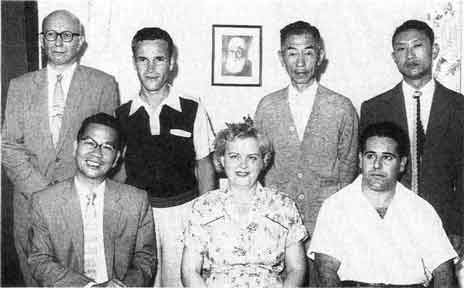 click for larger image The first Local Spiritual Assembly of the Bahá'ís of Macau, formed April 21, 1958. Front: Mr. Harry Yim, Mrs. Loretta Scherer (treasurer) and Mr. Joaquim Canhita. 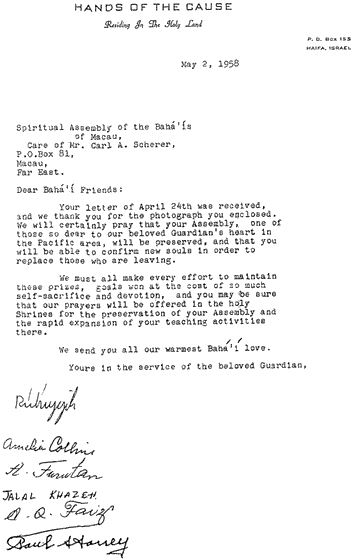 click for larger image In the period of time between the passing of the Guardian, Shoghi Effendi, in November 1957 and the election of the Universal House of Justice in 1963, the affairs of the Faith were guided by the Hands of the Cause of God residing in the Holy Land. Letters such as the above were a great encouragement, not only to the small group in Macau, but to Bahá'ís everywhere. 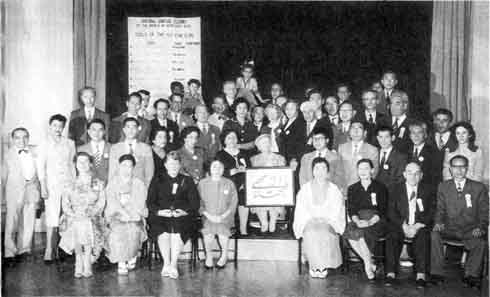 click for larger image This is a photo of the Third Convention of the Bahá'ís of North East Asia, held in Tokyo 1959. Macau had formed its first local spiritual assembly the year before and thus became eligible to send a delegate to the convention. It was no surprise when Mr. Yim was elected as delegate. He is shown a little left of the center, second row from the back, wearing glasses and a bow-tie. Hand of the Cause Miss Agnes Alexander is shown holding the frame containing the "Greatest Name".  click for larger image The Macau group sent out a very attractive greeting card in 1959. The dark parts, except for the lower center, are actually bright red. That first assembly, typical of many Bahá'í assemblies throughout the world, was an assortment of races: Chinese, Americans, and Portuguese. Mr. Jasai, a new Bahá'í, was a black Portuguese from Africa. By March 1959 there were ten Bahá'ís in Macau and the Scherers had left permanently to return to the United States. Later they pioneered to Portugal and in 1973 returned to Macau for about three months. Mr. Scherer is listed as being a member of the 1973 Local Spiritual Assembly. Members of the second Local Spiritual Assembly, elected 1959, were Mr. Yim, Mr. Chang, Mr. Mata, Mr. Joaquim Canhita, Mr. Peter Chou, Mr. Domingo Vilas, Mr. Wu Tze-Ming, Mr. William Yang and Mr. Jimmie Yuen.  click for larger image This was a moonlight meeting held on September 17, 1959 on the roof top of Mr. Chang' s residence. It was on the occasion of the Chinese Mid-Autumn Festival and was sponsored by the Local Spiritual Assembly. Seated: Mrs. Chang, Mrs. Liu, Miss Pan, Mrs. Pan, Mr. Jimmie Yuen and Mr. Yim. Standing: Mr. Chang, Dr. Liu, Mr. T.M. Wu, Mr. Yip and Mr. C. Short. The Portuguese Bahá'ís, all of whom were in the Portuguese Army, were not permanent. Mr. Manuel Catario Ferreira left for Portugal October 1958 and Mr. William Jasai left for Africa April 28, 1958. All of the Portuguese Bahá'ís had gone by 1960. Mr. Jimmie Yuen left for Hong Kong in December 1960. These were great losses for the small community. Mr. Azizi came almost every week from Hong Kong to help with the teaching. At that time the secretary of the community Mr. Yim, wrote to the National Spiritual Assembly in Tokyo, "In what way can we attract the hearts of the people?" [+CHAPTER7] Mr. Chang went with his wife and child as he said it would attract less attention. When he arrived in Haikow, Hainan, August 19, 1959, he sent a cable to Macau informing the community of his arrival. After he returned to Macau he mailed the cable to the National Spiritual Assembly in Tokyo. He reported later that some people showed interest in the Faith but said they would not dare to join a religion at that time. As Mr. Chang fulfilled the goal his name will be entered on the Roll of Honor of the Knights of Bahá'u'lláh, to be placed at the entrance of the Shrine of Bahá'u'lláh in Bahji in 1992.  click for larger image This is a copy of the cable sent by Mr. Chang to the Macau community telling of his arrival at Hainan on August 19, 1959. The contents of the cable are the words written in Chinese, that he arrived in Haikow, Hainan. The remaining numbers are Mr. Yim's address. [+CHAPTER8] In 1960 the community sent Naw-Rúz greeting cards to 24 Bahá'ís in eleven countries but received only two in reply, which caused the secretary to speculate that Naw-Rúz cards might not be a common practice among Bahá'ís. In 1960 the first all-Chinese Local Spiritual Assembly was elected. It consisted of Mr. Yim, Mr. Jimmie Yuen, Mr. Wu Tze-Ming, Mrs. Koo Hang-ngo, Mr. John Z.T. Chang, Mr. Peter Chow, Mrs. Margaret Chang (Chang Jui-chun), Harry Yim's mother Mrs. Pansi Yim (Yen Poon-si), and Mrs. Yeh Li Mei-t'ao.  click for larger image This was a Bahá'í picnic on the island of Coloane February 28, 1960. It was sponsored by the Macau Local Spiritual Assembly. The early work of the Bahá'ís was undertaken with great discretion on account of Portuguese officials. By the latter part of 1960, the Bahá'í community consisted of four women and eight men, all Chinese, as the last Portuguese Bahá'í left July 8 of the same year. The Bahá'í community was extremely transient; foreigners could seldom find work and the Chinese often considered Macau a stepping stone to somewhere else. The Chinese Bahá'ís tried to hold things together after 1960. Mr. Azizi alternated his time between Hong Kong and Teheran, but when he was in Hong Kong he frequently came to Macau to help with the teaching work. 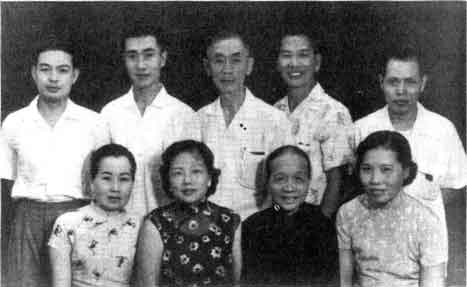 click for larger image This was the first all-Chinese Local Spiritual Assembly in Macau. It was elected in April 21, 1960. Seated: Mrs. Koo Lang-ngo, Mrs. Yeh Li Mei-t'ao, Mrs. Pansi Yim (Yen Poon-si) and Mrs. Margaret Chang (Chang Jui-chun). Standing: Mr. Jimmie Yuen, Mr. Peter Chow, Mr. John Chang, Mr. Harry Yim and Mr. Wu Tze-ming. In 1961 there were ten Bahá'ís on the list; Mrs. Yim had died and Mr. Yuen left Macau. Mr. Yim had firesides every Sunday between 4 P.M. and 6 P.M. One person declared that year, in September, Mr. Wai Mung Yip. In December they decided to have a party at Lee Kong Kee restaurant to bring together all the Bahá'ís and the friends who had been attending the firesides. It was at the time of the Chinese Moon Festival. In 1962 the secretary, Mr. Chang, wrote of the two islands of Taipa and Coloane. He said they had fishing villages and fireworks factories, with a small population, but that the people were simple and honest. They attempted some teaching on the islands but there were no declarations. Mr. Yim told one of the later pioneers that two or three Bahá'í men went teaching to Taipa Island. This was before the bridge was build and they had to take a ferry. For some reason they missed the last ferry and had to sit up all night in a mahjong parlor waiting for the first morning ferry. 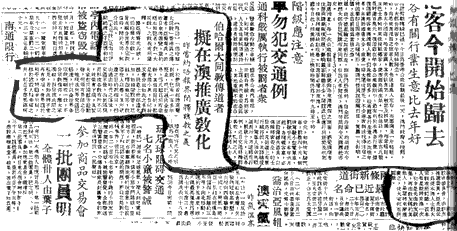 click for larger image There seem to have been many Bahá'í articles in the Hong Kong newspapers in those early days, but few in the Macau papers. However, this is an article printed in Macau in 1962. Although there was a Local Spiritual Assembly, between 1963 and 1965 activity was rather minimal. The Bahá'ís made inquiries about registering the Faith with the government in the 1960s but were told they had to have a reason to do so such as involving in charitable works. It seems few organizations were registered at that time. In the 1970s they again made inquiries. The Universal House of Justice advised them to wait until the Faith was registered in Portugal. A certificate of registration, dated January 28, 1976, was issued by the government of Portugal to the National Spiritual Assembly of the Bahá'ís of Portugal. The certification was equivalent to incorporation. This opened the way to pursue the same objective in Macau. In 1982 Macau was granted certification by the government. 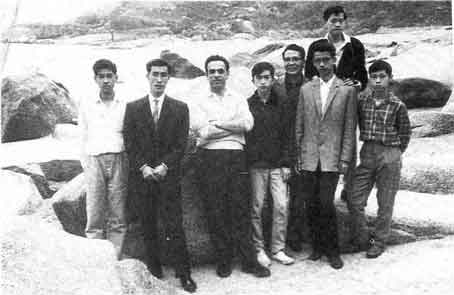 click for larger image Mr. Azizi, who was living in Hong Kong, made countless teaching trips to Macau through the years. This was a picnic in Coloane, February 25, 1962. Mr. Azizi is standing third from the left; Peter Chow is next to him (left). Mr. Yim, with glasses, is fourth from the right.  click for larger image The compiler, Mrs. Sims, enjoys the sights while on a visit to the Bahá'ís of Macau in 1963. At that time she was secretary of the National Spiritual Assembly of the Bahá'ís of North East Asia and was in close contact with the Macau community. 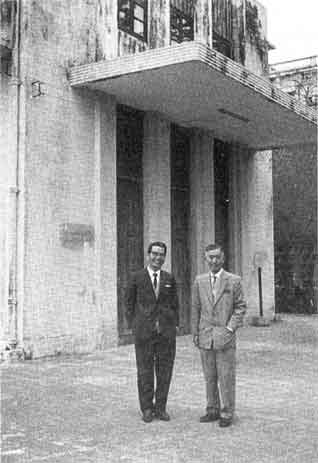 click for larger image Mr. Yim and Mr. Chang in front of Leng Nam School, 1963.  click for larger image The Local Spiritual Assembly of the Bahá'ís of Macau, elected April 21, 1963. Seated: Mr. Leong (Liang Chien-yeh), Mrs. Yeh Li Mei-t'ao, Mrs. Margaret Chang (Chang Jui-chun), Mrs. Koo Lang-ngo. Standing: Mr. Wa Tze-ming, Mr. John Chang (Chang Shao-tsai), Mr. Yeh Wei-ming, Mr. Harry Yim (Yen P'ei-feng) and Mr. Yang Yuen-han.  click for larger image On March 21, 1964 Mr. Yim was delighted when five youth declared their belief in Bahá'u'lláh. They had a party that night which Mr. Yim called a "banquet from God". It was paid for with $10 Mr. Scherer had sent them. [+CHAPTER9] In 1965 Mr. Yan Kee Leong and Mr. Leong Tat Chee visited Hong Kong and Macau. They spent four days in Macau, arriving September 24 and leaving the 28th. They stayed with Mr. Chang and went around with him and Harry Yim. They reported that Mr. Yip and his daughter-in-law seemed inspired. Again in March 1968 the two staunch Bahá'í friends made another trip to Macau. Harry Yim reported that they had a "good time" together. They were the first Bahá'ís of Malaysia to go travel-teaching out of their country. They also went to Hong Kong and Taiwan. Mr. Yan spent much time in Hong Kong and Macau in later years also. 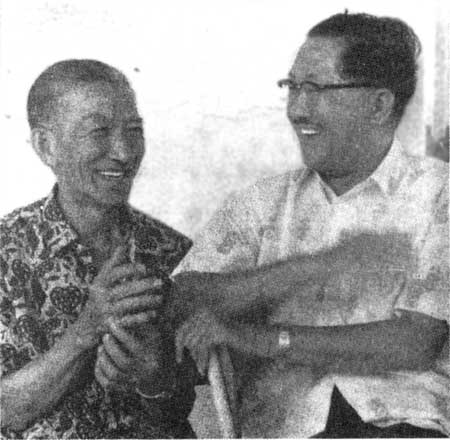 We have not been able to find a photo of either Mr. Yan Kee Leong or Mr. Leong Tat Chee taken while they were in Macau. The above photo was taken in Singapore 1969 where they were doing teaching and consolidation before Ridván. One of the great assets of the Faith is the diversity of its adherents. Mr. Yan Kee Leong and Mr. Leong Tat Chee, both of whom have passed on, were remarkable men by any standard. They were Malaysians of Chinese ancestry, especially interested in spreading the Faith among the Chinese in any country. Yan Kee Leong first heard of the Faith from Mrs. Shirin Fozdar and became a Bahá'í December 19, 1953. He was the first Bahá'í in Malaya, (now known as Western Malaysia) and he took the Faith to countless numbers of his fellow Malaysians, including some of the indigenous tribes of that country. In 1968 the Universal House of Justice appointed him to the Continental Board of Counsellors for Southeast Asia. He was the first counsellor of Chinese ancestry and he remained on that institution until his death in 1985. The second counsellor of Chinese ancestry was also Malaysian, Mrs. Rose Ong, daughter of Yan Kee Leong. She was appointed in 1985. Another daughter, Mrs. Lily Ng, affectionately known as "Auntie Lily", spent time teaching in Hong Kong and Macau in the late 1970s and 1980s. Mr. Leong Tat Chee first heard of the Faith from Dr. Fozdar, who, with his wife, was pioneering to Singapore. Another inspired Bahá'í teacher, Mr. Leong was appointed to the Auxiliary Board in 1965. As with Mr. Yan Kee Leong, many members of his family became Bahá'ís. 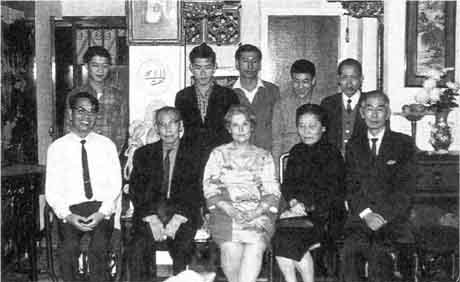 click for larger image Auxiliary Board Member Mrs. Orpha Daugherty went to Macau in February 1969 to help the progress of the Faith. She stayed two years. A devoted pioneer, warm and loving, she lived and taught the Faith in many countries in Asia. She died in 1985 in Taiwan. At the end of the 1960s teaching in Macau lagged until Auxiliary Board Member Mrs. Orpha Daugherty came in February 1969 to help re-establish the Spiritual Assembly. It was elected in April 1969. Mrs. Daugherty stayed in Macau about two years. A new Bahá'í Center, a large apartment, rented by the National Spiritual of North East Asia, was opened on Naw-Rúz 1969. At that time there were eleven adults and one youth on the Bahá'í list. Mr. Leonard Lewis, a British man, a teacher by profession, became a Bahá'í in Hong Kong and remained there to pioneer. He visited the friends in Macau several times. He said Mr. Yim decorated the rented Macau Center with some of his beautiful antiques. The apartment was kept only a year or so. Mr. Lewis admired the Bahá'ís of Macau. He wrote to the compiler that knowing how much the Chinese loved food, the fact that during the Fast they could go without food for the love of God, was quite remarkable! Both Macau and Hong Kong were far away from the National Spiritual Assembly of North East Asia, whose seat was in Tokyo. Korea and Taiwan, originally a part of the National Spiritual Assembly of North East Asia had already formed their own National Spiritual Assemblies. It was just a matter of time when Hong Kong and Macau would leave the mother assembly and become independent. To assist in the process, the National Assembly in 1968 decided to appoint a large committee in Hong Kong which was called the National Administrative Committee. This committee took care of the teaching and much of the administrative work in Hong Kong and also Macau. Mrs. Mary Tung Shia, the first Chinese woman to become a Bahá'í in Macau was one of the Bahá'ís appointed to the new committee. She and her husband were then living in Hong Kong. [+CHAPTER10] Mr. Duncan has done great service in various countries of Asia. He was designated as Knight of Bahá'u'lláh for being among the first to pioneer to Brunei, in 1954, during the Ten Year Crusade. Brunei, like Macau, was mentioned by the Guardian as one of the areas to be opened to the Faith. Mr. and Mrs. David Mockon, pioneers from the Philippines, arrived in Macau April 1972. At that time there were eight believers there including the three pioneers. In those years Local Assemblies could be formed during the year. In July of 1972 an all-Chinese Local Spiritual Assembly was elected. The election was the first since 1969. In 1973 more pioneers came; Miss Jane Jones and the Thomas Lane family from the United States. Mr. and Mrs. Carl Scherer came back to Macau for three months in 1973. As the general economy became more prosperous, the 1970s saw a large gain in pioneers almost everywhere in the Bahá'í world. This was noticeable in the Orient. 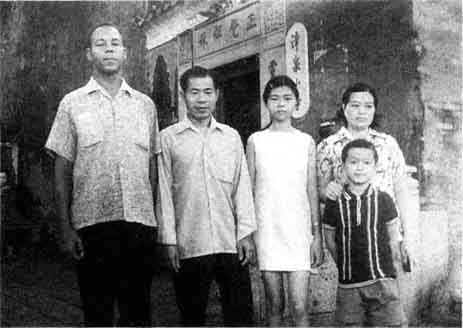 click for larger image In 1972 there was some intensive teaching done on the island of Taipa, by Bahá'ís living in Macau and also by Bahá'ís from Malaysia who were pioneering to Hong Kong. During a memorable teaching trip it was reported that over 100 people living on the island heard about the Faith and nine became Bahá'ís. Two Malaysian Bahá'ís Mr. Tei Teik Hoe and Mr. Yin Hong Shuen, who were pioneering in Hong Kong made a teaching trip to Macau in 1972. They described teaching in Taipa. A hundred islanders milled around the Bahá'ís, took all their pamphlets, and by the time the Bahá'ís boarded the boat to go back to Macau they left behind nine Bahá'ís. A Local Spiritual Assembly was formed in Taipa that year but it was not elected again the following year. By 1973, including pioneers, there were eighteen believers spread out in three localities, Macau, Taipa and Coloane. Later the membership climbed to 32 which included seven youth. In 1973 the Macau community was assigned four delegates to represent Macau at the first National Convention of the Bahá'ís of Hong Kong which was to be the following year. Macau was not included in the name of the new assembly but was under its jurisdiction. As the Bahá'ís increased, a permanent Bahá'í Center became increasingly needed. In 1973 negotiations were started by Mr. H. Azizi to purchase a flat in a convenient location. By 1974 there was a Bahá'í Center for Macau, a donation from Mr. Azizi. In March 1974 mainly due to teaching efforts of several dedicated pioneers and travel teachers the Bahá'í membership climbed to 36 adults with eleven youth. A few months later reports showed 47 adult Bahá'ís and twelve youth in the three areas of Macau. In January 1974, according to a statistical report, there were now 68 Bahá'ís which included nineteen youth. Macau was taking off, and would continue to grow and eventually take the Faith of Bahá'u'lláh into the homeland, China. In April 1974 the National Spiritual Assembly of the Bahá'ís of North East Asia ceased to exist as the last area, Hong Kong, formed its own National Spiritual Assembly with Macau under its jurisdiction. The National Spiritual Assembly of North East Asia sent Mrs. Kimiko Schwerin as its representative to that first Convention. At the same time, in Tokyo, the National Spiritual Assembly of the Bahá'ís of Japan came into existence with Hand of the Cause Mr. William Sears representing the Universal House of Justice. After that there was very little direct contact between Macau and the National Spiritual Assembly of Japan. Recognition should be given to the many Malaysian Bahá'í travel teachers who traveled to various countries during the 1970s and are still continuing to spread out at this writing. During the teaching campaigns started by Hand of the Cause Dr. Muhajir in Hong Kong during the early 1970s, at one time there were 30 Bahá'ís from Malaysia, Singapore and Thailand. In 1975 a Malaysian Singing Group went to Macau and gave a singing fireside meeting. Eighty people attended, including 40 seekers. The group also gave performances in Hong Kong. 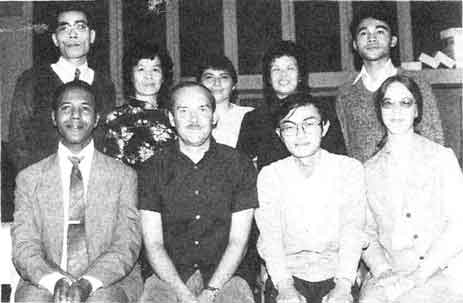 click for larger image The Local Spiritual Assembly of Macau in 1974. Seated: Mr. Charles Duncan, Mr. Thomas Lane, Mr. David Mockon, Miss Jane Jones. Standing: Dr. Lai, Mrs. Lai, Mrs. Elaine Lane, Mrs. Ma and (unknown).[+CHAPTER11] We cannot find evidence that those Bahá'ís who were posthumously designated as Hands of the Cause, Miss Martha Root and Mrs. Keith Ransom-Kehler stopped in Macau, although they were in Hong Kong. Hand of the Cause Mr. Siegfried Schopflocher was also in Hong Kong for a week in 1927 but made no mention of Macau in the articles of his trip as printed in the Star of the West. It seems that several Bahá'ís in those very early days approached mainland China through Hong Kong, but they did not go to Macau. According to our research, the first Hand of the Cause to visit Macau was Mr. Zikru'llah Khadem, on November 20, 1953. At that time there was only one Bahá'í living in Macau, Knight of Bahá'u'lláh Mrs. Frances Heller. Of that visit she wrote, "(I) received a telegram informing me of the arrival of our beloved Hand of the Cause and Bahá'í brother Mr. Khadem. I could not go to meet him for there was a typhoon warning. . . sat at home praying to speak to him over the telephone at least. About 6:30 A.M. my door began to rattle and who should be there but Mr. Khadem". Mrs. Heller herself had arrived in Macau only a month previously. She took him around to meet her neighbors. Mr. Khadem visited for the second time November 16, 1955. Mr. Jalal Khazeh visited Macau on July 9 and 10, 1957, Mr. Shu'a'u'llah Ala'i December 9, 1959, Mr. A.Q. Faizi in January 1969, Dr. Ramat'u'llah Muhajir in 1972 and probably both earlier and later, Mr. Collis Featherstone made a one day trip to Macau May 17, 1966. In July 1968 he went to Macau with Counsellors Mumtazi and Yan Kee Leong. He again visited in 1972, and also later. Miss Alexander first visited on November 25, 1960. It was reported that she met all the Bahá'ís. Ruhiyyih Khanum included Macau in her itinerary several times, starting in 1972.
It is thought that Mr. Zikru'llah Khadem was the first Hand of the Cause to visit Macau. This photo was taken during his second visit. He and wife arrived at 6 P.M. November 16, 1955 and left the next day. The Bahá'ís celebrated their arrival with a dinner at Long Kei restaurant with fifteen people attending, which included five non-Bahá'ís. After dinner Mr. Khadem spoke at a meeting at the Scherer's residence with 19 people attending, including eight non-Bahá'ís. 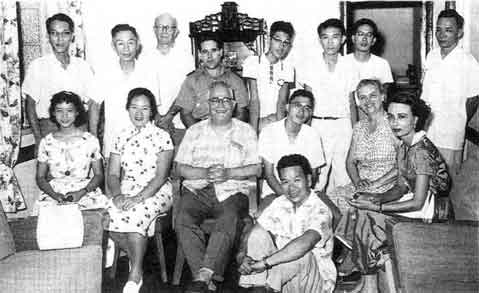 click for larger image On July 9 and 10, 1957 Hand of the Cause Mr. Jalal Khazeh visited Macau on his way back to Teheran from Japan, where he had attended the first National Convention of the Bahá'ís of North East Asia. A special meeting was held in Macau and, according to records, Mr. Khazeh gave an inspiring talk to six Bahá'ís and nine inquirers. 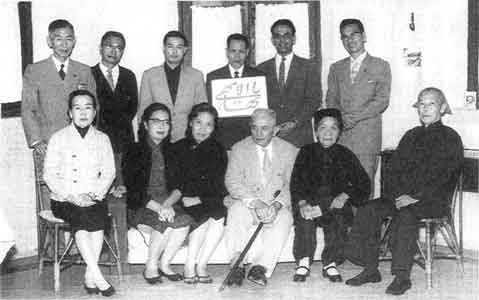 click for larger image Hand of the Cause Mr. Shu'a'u'llah Ala'i visited Macau December 9, 1959. He arrived at 6 P.M. and left at midnight. 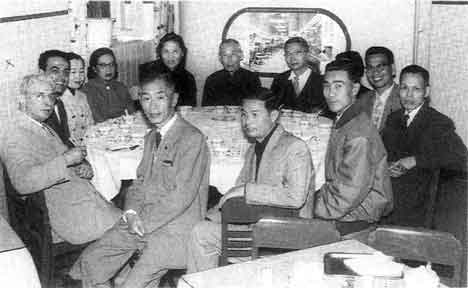 click for larger image 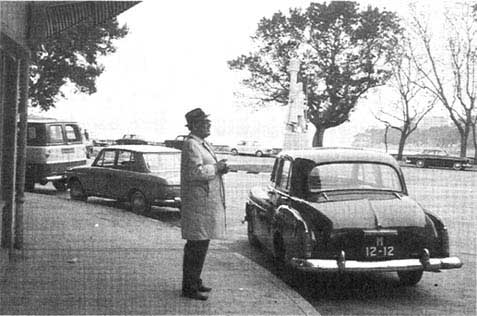 Hand of the Cause Mr. A.Q. Faizi visited Macau for one day in January 1969. He is shown here observing the sights. As he gazed at the mainland (in the middle background) the compiler recalls him saying he would like to live in Macau, near China. 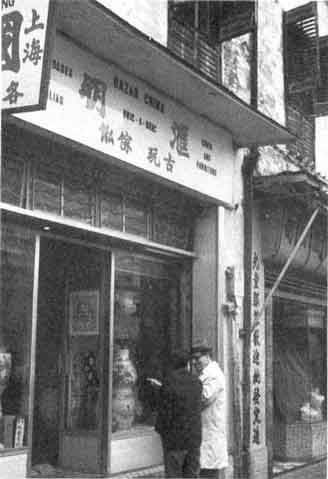 click for larger image Mr. A.Q. Faizi speaking with one of the Bahá'ís in front of Mr. Yim's antique shop in Macau. 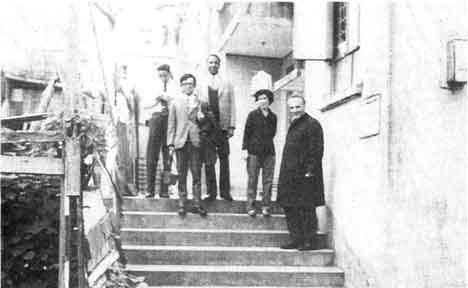 click for larger image Hand of the Cause Dr. Ramat'u'llah Muhajir (far right) visited Macau in the 1970s. From the left is Dr. Lai, Mr. Lawrence Ip, Mr. Charles Duncan and Mrs. Lai.  click for larger image Hand of the Cause Mr. Collis Featherstone is shown visiting with some of the Macau Bahá'ís in August 1972. From the left, Dr. and Mrs. Lai's child. Mr. Charles Duncan, Mr. Harry Yim, Mr. Featherstone, Mrs. Lai, Dr. Lai, Mr. H. Azizi and Mrs. Baby Cruz Mockon. 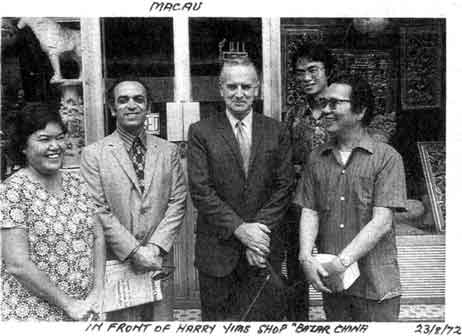 click for larger image Hand of the Cause Mr. Featherstone is shown in front of Harry Yim's shop "Bazar China". This photo was taken August 23, 1972. From the left: Mrs. Baby Cruz Mockon, Mr. H. Azizi, Mr. Featherstone, Mr. David Mockon and Mr. Yim. [+CHAPTER12] National Spiritual Assembly of the Bahá'ís of Hong Kong In April 1974 the National Spiritual Assembly of Hong Kong which included Macau in its jurisdiction, was elected. Macau was assigned four of the fifteen delegates to the Convention. Two pioneers in Macau were elected to the first National Spiritual Assembly of the Bahá'ís of Hong Kong: Mr. Thomas Lane, who became its chairman, and Mr. Charles Duncan. Amatu'l-Bahá Rúhíyyih Khánum represented the Universal House of Justice at that Convention.  click for larger image The first National Spiritual Assembly of the Bahá'ís of Hong Kong was elected during Ridván 1974. Macau was under its jurisdiction for fifteen years. [+CHAPTER13] To the Bahá'ís of Macau Ridván 1989 Dearly loved friends, On the occasion of your first National Convention we convey our warm greetings and express our admiration for the sterling accomplishments of your dearly loved community since the Knights of Bahá'u'lláh opened Macau in response to the call of the beloved Guardian at the commencement of the Ten Year Crusade. The early years of the Bahá'í community in Macau witnessed many struggles and uncertainties, but the steadfast and devoted efforts of the pioneers and local believers over the years have won for you the privilege of entering a new and highly promising phase of development, fully vindicating the decision to establish this Ridván a new National Spiritual Assembly on the doorstep of China. A new spirit is manifest; new challenges are before you; new opportunities are evident as your community crosses the threshold to independence and assumes new tasks and responsibilities. Precious new souls have joined your ranks. As they become increasingly aware of the part they should play in the ever-unfolding destiny of the Macau Bahá'í community and are encouraged to participate in its affairs they will greatly assist in advancing the Cause of Bahá'u'lláh in the region. Barely a decade separates Macau from its return to its homeland, that vast and ancient land which in these days is the object of so much hope and promise. The role of the Macau Bahá'í community in establishing the Faith of Bahá'u'lláh among the Chinese people is patently clear. Its future is bright; its steadfastness and dedication are daily being exemplified. We are confident that the light of guidance will burn ever more radiantly in Macau, that nothing in this changing world will deter you from pursuing your goals and that you will attract added blessings and divine confirmations. Be assured that our loving prayers will surround you. We will supplicate at the Holy Threshold that you will be continually strengthened and that you will attain the high honor of fulfilling your glorious destiny. With loving Bahá'í greetings, (signed) The Universal House of Justice  click for larger image The first National Spiritual Assembly of the Bahá'ís of Macau elected Ridván 1989. Hand of the Cause Amatu'l-Bahá Rúhíyyih Khánum represented the Universal House of Justice on this occasion as she had done some years earlier at the first election of the National Spiritual Assembly of the Bahá'ís of Hong Kong. Seated: Mrs. Sheevash Farid, Miss Candy Fok, Mrs. Myriam Marrero, Amatu'l-Bahá Rúhíyyih Khánum, Counsellor Bijan Farid, Mrs. Lee Tsui Siu Hing, and Miss Annie Ng. Standing: Mr. Herbert Lee, Mr. Donald Tennant, Mr. Kong Siew Huat and Mr. Dale Eng. 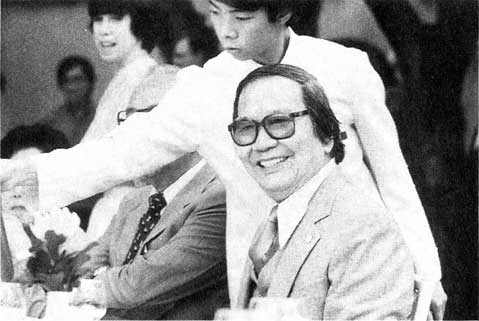
Mr. Yim, the first Chinese Bahá'í in Macau, happily attending the first Annual Convention of the Bahá'ís of Macau, 1989. 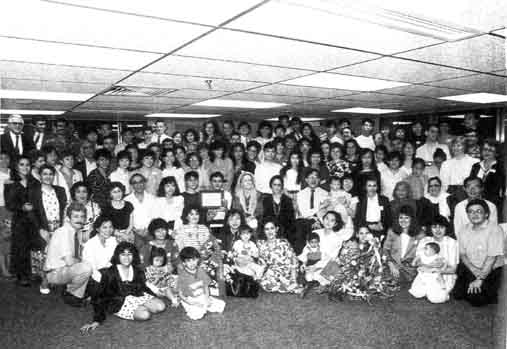 click for larger image The first National Convention of the Bahá'ís of Macau, 1989. Amatu'l-Bahá Rúhíyyih Khánum is sitting in the middle, wearing a veil. 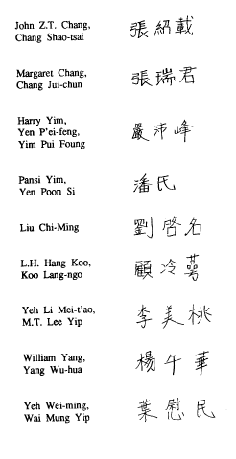 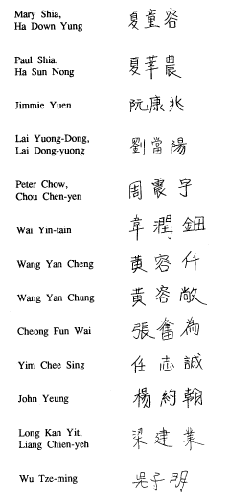 Afterword During a speech in the London Congress, mentioned in the early part of this record, Hand of the Cause Mr. A.Q. Faizi, indicated that we should never forget the early believers, because we are "standing on their shoulders," that is, we are standing on their service, standing on what they built. As the Macau community was under the jurisdiction of the National Spiritual Assembly of the Bahá'ís of North East Asia from 1957 until 1974 there was a variety of material, letters, reports and some photographs in the National Bahá'í Archives in Tokyo. Before that, from 1953 to 1957 the Macau community corresponded directly with the Asia Teaching Committee of the National Spiritual Assembly of the Bahá'ís of the United States. Fortunately copies of some of the very early correspondence turned up in Mr. Yim's papers in Macau. As with writing the history of the Faith in Japan, the compiler talked to as many Bahá'ís as she could find who knew about this subject. But there were not many, and sometimes there were great discrepancies between an individual's memories of events and events as they were recorded at the time. In such cases we relied on written records when they were available. The compiler, who was a member of the first National Spiritual Assembly of the Bahá'ís North East Asia, made use of all material she came upon, not only in Japan, but also in Macau and Hong Kong. The research for this account was taken from primary research sources. As it is a "first", so to speak, for Macau, great attention was paid to detail; the compiler felt that more was better than less. One might wonder at the attempt to record such details as a chronological list of early believers. Often the span of their activities was extremely short and soon they disappeared. We are reminded of a phrase of Bahá'u'lláh, "The whole duty of man in this Day is to attain that share of the flood of grace which God poureth forth for him. Let none, therefore, consider the largeness or smallness of the receptacle. The portion of some might lie in the palm of a man's hand, the portion of others might fill a cup, and of others even a gallon-measure." (from Gleanings from the Writings of Bahá'u'lláh) If some of the early believers had only a palmful to receive — or to give — still we must honor them, as the Faith, seemingly so small and insignificant in those early days, needed their bit. Who is to say that when the Faith shines with full glory in ages to come those bits may not equal oceans? The Chinese names posed problems for the compiler. Often the Chinese Bahá'ís when speaking or writing in English preferred to use English first names that they had selected, to go with simplified phonetic surnames (or family names). And sometimes the Chinese names had two or three different transliterations or different ways of writing. We have tried to include as much information as possible regarding Chinese names. For some of the names we could find the original Chinese characters which we have included in an end chapter. Mrs. Mary Shia was not the first Chinese woman to become a Bahá'í. There were others, though not many. But she was the first in Macau and the first woman of Chinese background to become an active Bahá'í in Hong Kong. Mr. Anthony Seto (1890-1957), who was born in Hawaii of Chinese parents was the first Chinese-American Bahá'í. He and his wife became Bahá'ís in the fall of 1916 in Hawaii. About May 1916 a mainland Chinese, Mr. Chen Hai An, who was studying in the United States, apparently became a Bahá'í. He eventually returned to Shanghai, China and there is no record of him after that.
|
| METADATA | |
| Views | 225866 views since posted 2000; last edit 2025-01-28 14:58 UTC; previous at archive.org.../sims_macau_bahai_community; URLs changed in 2010, see archive.org.../bahai-library.org |
| Language | English |
| Permission | author |
| History | Scanned 2000 by Jonah Winters; Formatted 2000 by Jonah Winters; Proofread 2000 by Barbara R. Sims. |
| Share | Shortlink: bahai-library.com/411 Citation: ris/411 |
|
|
|
|
Home
search Author Adv. search Links |
|